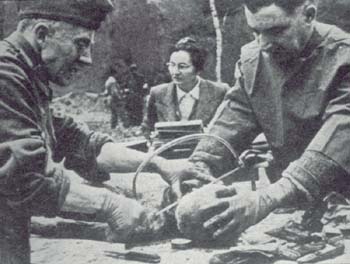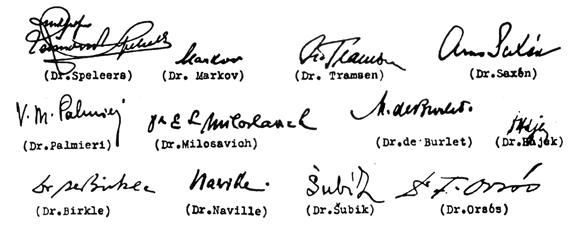Smolensk, 30 April 1943
TRANSCRIPT
Recorded as a conclusion of the examination of mass graves of Polish officers in the forest of Katyn near Smolensk by leading representatives of European forensic medicine and criminology schools and other renowned university professors. From 28 to 30 April 1943 a commission composed of leading representatives of European forensic medicine and criminology schools and other renowned medical university professors conducted a scientific examination of the mass graves of Polish officers in the forest of Katyn near Smolensk.
The commission consisted of the following gentlemen:
1) Belgium: Dr. Speleers, Professor of Opthamology an the University of Gent.
2) Bulgaria: Dr. Markov, Forensic Medicine and Criminology teacher at the University of Sofia.
3) Denmark: Dr. Tramsen, Prosector at the Institute of Forensic Medicine in Copenhagen.
4) Finland: Dr. Saxén, Professor of Pathological Anatomy at the University of Helsinki.
5) Italy: Dr. Palmieri, Professor of Forensic Medicine and Criminology at the University of Naples.
6) Croatia: Dr. Miloslavich, Professor of Forensic Medicine and Criminology at the University of Agram.
7) Netherlands: Dr. de Burlet, Professor of Anatomy at the University of Groningen.
8) Protectorate of Bohemia and Moravia: Dr. Hajek, Professor of Forensic Medicine and Criminology in Prague.
9) Rumania: Dr. Birkle, Forensic Doctor of the Rumanian Ministry of Justice and first assistant at the Forensic Medicine and Criminology Institute in Bucharest.
10) Switzerland: Dr. Naville, Professor of Forensic Medicine at the University of Geneva.
11) Slovakia: Dr. Subik, Professor of Pathological Anatomy at the University of Bratislava and Slovakian Chief of State Public Health Works.
12) Hungary: Dr. Orsós, Professor of Forensic Medicine and Criminology at the University of Budapest.
Also present during the inspection and deliberations were
1. Dr. Buhtz, Professor of Forensic Medicine and Criminology at the University of Breslau. He was authorized by General Headquarters of the German Army to be in charge of the excavations in Katyn.
2. Dr. Costedoat, Medical Inspector, ordered to be present during the inspection of the Commission by the head of the French Government.
The discovery of mass graves of Polish officers in the forest at Katyn near Smolensk that was recently brought to the attention of German authorities has caused Dr. Conti, the State Health Leader, to invite the above mentioned specialists from several European countries to come to Katyn to examine the site and help with the clarification of this unique case.
The Commission personally interviewed a few local Russian eyewitnesses who confirmed that in the months of March and April 1940 large railway transports of Polish officers were unloaded almost daily at the Gniesdowa railway station near Katyn. The officers were then transported to the Katyn forest by trucks and were never seen again. The commission also took further notice of previous discoveries and determinations and examined the recovered evidence. By 30 April 1943, 982 corpses had been exhumed. Of those, about 70% were immediately identified while the papers of the others will be utilized for identification only after a careful pretreatment. The corpses that were dug up prior to the arrival of the Commission were viewed as a group and autopsies were performed by Professor Buhtz and his co-workers on the majority of them. Seven mass graves were opened up of which the largest contained an estimated 2,500 bodies. The members of the Commission personally performed autopsies on nine corpses while many specially chosen corpses were submitted to a coroners inquest.
Forensic conclusions of the completed reviews and examinations.
The cause of death of all the exhumed corpses is without exception a shot in the head. Mostly single shots in the nape of the neck, but in a few cases double shots. In one instance there were three shots in the nape of the neck of the corpse. The entry wound is typically located at the nape of the neck and leads through the bone of the back of the skull and into the cavity in which the spine terminates. The exit wound is usually in the area of the forehead/hairline. All victims were killed by pistol shots of a caliber of under 8 mm.
As a result of the explosion of the skulls, the residue of burned powder in the area of the entry wound, and the similar locations of the entry wounds it is concluded that the victims were shot at point blank range. The direction of the shot is the same, with only a few exceptions. The noticeable similarity of the wounds within a very limited region on the back of the skull shows a practiced hand. On many corpses the hands were bound in a standard way, and in a few cases bayonet wounds in clothing and skin were noted.
 Corpses of Russian civilians that were also exhumed in the forest of Katyn had their hands bound like those of the Polish officers, even though the Russians were buried much earlier. It was concluded that the Russian civilians were also shot in the nape of the neck by a steady, practiced hand. In one instance a Polish officer that had already been killed by a neck shot was subsequently hit by a bullet that had killed another officer. Only the outer bone surface was damaged by the bullet. This probably proves that the shootings actually took place in the open graves, thereby eliminating the necessity of transportation to the graves.
Corpses of Russian civilians that were also exhumed in the forest of Katyn had their hands bound like those of the Polish officers, even though the Russians were buried much earlier. It was concluded that the Russian civilians were also shot in the nape of the neck by a steady, practiced hand. In one instance a Polish officer that had already been killed by a neck shot was subsequently hit by a bullet that had killed another officer. Only the outer bone surface was damaged by the bullet. This probably proves that the shootings actually took place in the open graves, thereby eliminating the necessity of transportation to the graves.
The mass graves are located in clearings in the forest and have been completely obliterated by flattening the earth and planting small young pine trees. The Commission members themselves and a statement from a hired consultant, Chief Forester von Herff, concluded that the pine trees were a maximum of five years old, were poorly developed because of the shade and were probably planted at this spot about three years ago. The mass graves are laid out like steps in the hilly sandy land. They reach ground water in some places.
Nearly all corpses were found laying in the prone position, very close together or overlapping each other. Towards the ends they are clearly arranged while in the center the arrangement is more irregular. In nearly all cases the legs are stretched out. The arrangement is obviously systematic. The entire Commission agreed that the exhumed corpses were dressed in clothing that exhibited distinguishing Polish characteristics such as buttons, insignia of service rank, decorations, military boots, laundry labels, etc. It is all winter clothing: furs, leather jackets, sweaters, heavy boots and typical Polish hats. Only a few of the corpses were not officers - one of them was a clergyman. The sizes of the clothing was consistent with the sizes of the bodies it was found on. Underwear was buttoned in an orderly way, suspenders and belts fastened as usual. From that it was concluded that the uniforms were being worn at the time of death and burial.
No watches or rings were found on the bodies, although watches must have been present around the time of death as detailed times were found in notes in dairies. Precious metals were found only in hidden places on a few corpses, but many corpses still had gold teeth. Lots of Polish bank notes were found along with a substantial amount of small change. Also found were packages of Polish cigarettes and matches. A few boxes of tobacco and cigarette holders were found engraved with the word "Kozielsk" (the name of the last Soviet prison camp of the victims). Documents found with the corpses (diaries, correspondence, newspapers) all dated from the fall of 1939 through March and April 1940. The last noted date is that on a Russian newspaper of 22 April 1940.
Different levels of decomposition among the corpses were noted. The level of decomposition depended upon where in the grave the body was taken from. The bodies found on top and on the sides of the mass graves were mummified, whereas bodies taken from the middle of the graves were still moist. Many corpses were stuck together by thickened body fluids. Deformation of many corpses resulted from the pressure exerted by the weight of the carefully arranged bodies above. None of the bodies showed any signs of insects or remains of insects that could date from the time of the burial. Noting this it was concluded that the executions and burials had to have taken place during a cold, insect-free time of year.
A large row of skulls were checked for irregularities. This was very important for Dr. Orsós to try to estimate the time of death. The skulls had a multi-layered volcanic limestone incrustation on the top side of the loamy homogenized brain mash below. The appearance of this combination will not be found in corpses that have laid in a grave for less than three years. A very pronounced example of this combination was found in the skull of corpse number 526, located in the top layer of a large mass grave.
Recapitulation of the verdict
Seven mass grave sites of Polish officers in the forest of Katyn were researched by the Commission. 982 bodies were exhumed, partially autopsied and studied. Seventy percent have been identified.
The cause of death of all the victims was a shot in the nape of the neck. From eye witness reports and from correspondence, diaries and newspapers found with the bodies it is concluded that the shootings took place in the months of March and April 1940. We are all in complete agreement with the findings written in the transcript regarding the mass graves and the individual corpses of Polish officers.

